SMS Prinz Adalbert slips into the Baltic:
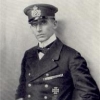
Posted 03 February 2018 - 05:25 PM
HMS Mansfield, a Hawthorn M-class destroyer:
Mansfield, one of just two Hawthorn M-class DD's, survived the war to be scrapped in 1921. The M-class DD's were divided into the Hawthorns in their four-funnel configuration, the Admiralty M-class with three funnels and the two-funnel Yarrows. All featured three 1x4-inch gun mounts and two twin 21-inch torpedo mounts. The M-class was the numerically largest class of WWI British destroyer.
Posted 12 May 2018 - 09:36 PM
Semi-dreadnought Condorcet from a period illustration:
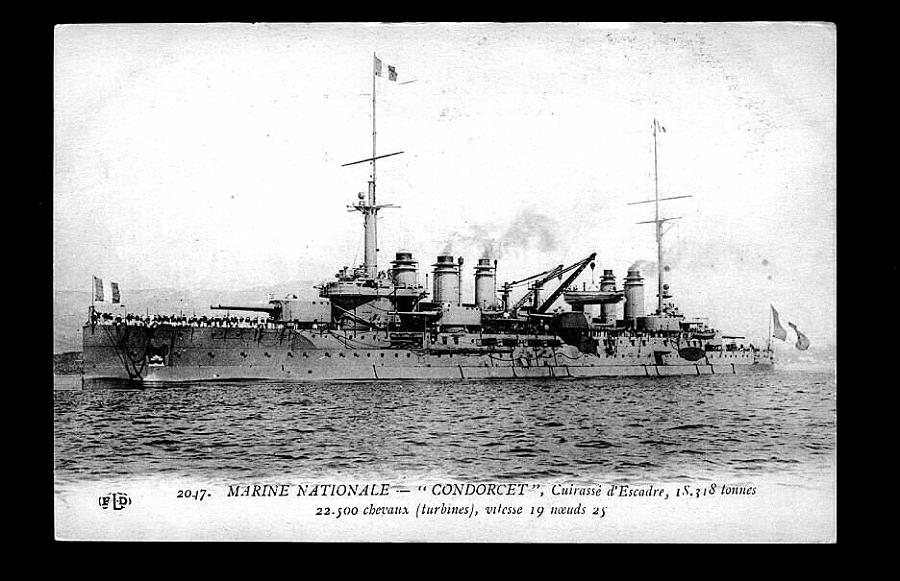
We've been working on a "Second Battle of Otranto Strait", featuring a clash of Austro-Hungarians and the French. Perhaps a bit contrived, but by God, we're going to get these French guys on the table. We'll probably do it the same day as the "Battle of the River Plate", since we suspect that one won't run for hours. We'll see what the Austrians and the French can muster...
Healey
Posted 27 May 2018 - 02:23 PM
The table remains silent for the moment...a number of other projects/events have emerged to consume the calendar. Slipped down to Annapolis the other day to catch the Blue Angels completing their rehearsals for academy graduation...never cease to amaze me. No pics, though...forgot the camera.
Swung by Matt Schreck's place last Monday to pick up some ships he painted for me...he's helping knock down the lead pile. Here's SMS Baden in 1/2400:
Posted 01 June 2018 - 05:14 PM
Second Battle of the Otranto Strait - July 25, 1917
Upon debriefing and subsequent review of the first attempt to disrupt the Otranto Barrage in May 1917, Grossadmiral Maximillian Njegovan, with the Archduke’s assent, began planning a return in force, this with the intention of not only destroying a sizable portion of the barrier, but to push beyond and disrupt the patrolling Allied navies forming the blockade. The Archduke’s only requirements for the operation was that it should be executed with second-tier forces, preserving top-of-the-line units of the navy for possible future operations.
With his plans developed, Njegovan called upon Franz von Keil, commander of the 2nd Battleship Division, to lead the operation. A secondary force, consisting of the light cruiser Novara and four Tatra-class destroyers (Czepel, Lika, Orjen and Triglav) would attack the drifters cruising the barrier. The main body, consisting of battleships Erzherzog Karl, Erzherzog Friedrich and Erzherzog Ferdinand Max, together with armored cruisers Sankt Georg and Kaiser Karl VI, would press through a gap found in the barrier some twenty miles east of the intended attack on the drifters, falling upon any patrolling Allied units beyond.
On July 21, U-20, commanded by Hermann Rigele, confirmed passage through the barrier thirty-seven nautical miles due west of Corfu. Rigele would maintain his position, submerged by day, to report each night the movements of heavy units in his immediate area. Other than a sighting of a British cruiser on the evening of July 23, Rigele reported few comings-and-goings in his zone.
Njegovan ordered Von Keil to sea on the evening of the 24th, intending to pass through the Barrier early the following morning. Novara and the destroyers departed Pola ahead of Keil’s main body, launching their attack on the drifters around 0100. With all hell breaking loose some twenty miles to their west, the main body passed through the barrier at 0440 into the open Mediterranean beyond.
In late June French Rear Admiral Joseph de Sugny had been sent by CinC Gauchet with a sizable force to patrol the Greek coast off Sapientza. Other than their successful evasion of a submarine attack on the afternoon of July 8, de Sugny’s force had seen little of the enemy. After a further two weeks of patrolling the straits, de Sugny’s force was ordered back to the naval base at Toulon for refit. On their return journey, Gauchet ordered de Sugny’s force to make a slow pass of the Otranto Barrier in support of the blockade operation. Gauchet intended this to be a show of support for the British naval units patrolling the western end of the barrier.
De Sugny’s force consisted of the pre-dreadnought battleships Condorcet and Diderot, armored cruisers Dupleix and Desaix, and Bisson-class destroyers Bisson, Protet, and Magon. De Sugny aligned his ships with the three destroyers forming the van, then his pair of battleships, with the cruisers bringing up the rear. At 0320 on the 25th de Sugny passed the headlight at Moraitika, then turned west-northwest at 16 knots. With nary a cloud in the sky, there is a brisk wind on the water with a fair bit of chop. At 0510, with the rising sun at his back, de Sugny received a report of smoke on the horizon off his starboard bow. Twelve minutes later came a further report – Austrian BB’s on a southeasterly bearing. De Sugny gives the order to action stations.
Log Sheet
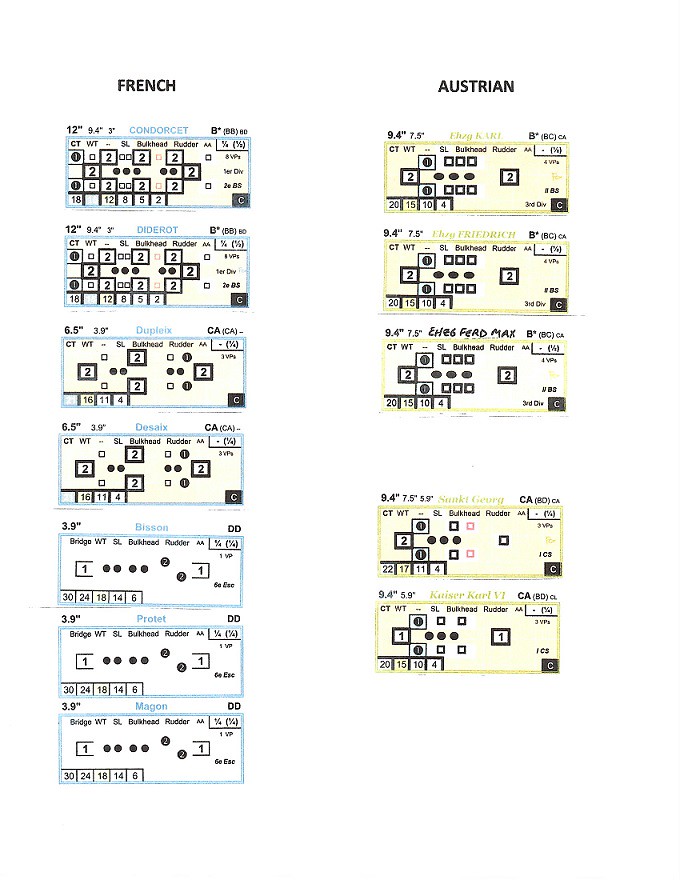
After Action Report
At 0528 de Sugny orders a course change to due-west, continuing at 16 knots. Von Keil, who has only now received word of an approaching enemy due to the sun in his face, orders speed be increased to 20 knots, continuing on an east-southeasterly heading. Six minutes later, with reports confirming at least two French BB’s amongst four capitals, and a vanguard of three or four destroyers, Von Keil orders Sankt Georg and Kaiser Karl VI to break off on a southerly heading, continuing at 20 knots.
De Sugny decides to divide his force as well, sending the van ahead at 25 knots. From the bridge of Condorcet he observes the Austrian turn his force of three BB’s slightly further on an east-southeast heading. Reports come in that the enemy force is comprised of three Erzherzog Karl-class battleships and two armored cruisers. Confidant he has the Austrian outgunned, de Sugny continues on his current heading.
At 0558 Erzherzog Karl opens on Condorcet at 13,200 yards, the salvo passing safely overhead. The Austrian cruisers turn southeast, intending to intercept the rapidly approaching French destroyers.
Six minutes later de Sugny orders his BB’s and trailing cruisers to make an abrupt turn north toward the Austrian main column, while his van of destroyers continues west at 25 knots. Von Keil, somewhat troubled by the Frenchman’s division of his force, orders Erzherzog Karl to continue fire on Condorcet and Erzherzog Friedrich to deliver a salvo on Diderot. Sankt Georg opens on the lead destroyer at a range of 9,200 yards. Everything misses.
De Sugny, his watch reading 0610, orders his main column and the van to turn sharply to the northeast. Orders are radioed to the destroyers as they heel over in their tight turn to make a torpedo run against the column of battleships. Condorcet opens on Erzherzog Ferdinand Max at 11,200 yards, missing badly.
The Austrians return fire, Erzherzog Karl firing on Condorcet from 11,200 yards and Erzherzog Friedrich opening on Diderot…everything misses, but Sankt Georg manages a pair of hits on Bisson from 9,200 yards, inflicting engineering damage and wrecking her starboard torpedo mount.
By 0616 Condorcet has closed to 9,200 yards on lead BB Erzherzog Karl. Firing a full four-turret 12-inch broadside, she misses yet again. Diderot manages a hit on Erzherzog Friedrich, but it fails to penetrate. The Austrian BB’s return fire and also miss, the range now just 10,000 yards or less. Sankt Georg manages a pair of hits on Magon, holing her badly on her port side. The destroyer’s speed drops sharply.
De Sugny continues on his present course, rapidly closing on the Austrian battle-line. At 0622 Condorcet fires again, this time striking Erzherzog Karl below the rail, wrecking one of her 7.5-inch casemates (unusable in these rough seas). Diderot’s second salvo on Erzherzog Friedrich misses.
Von Keil, cursing under his breath, watches as his flag Erzherzog Karl fires again, now from just 8,000 yards, only to fall short. A similar result is achieved by Erzherzog Friedrich just astern. Meanwhile, Ferdinand Max has turned her 9.4-inchers on the rapidly closing destroyers. She too misses, but Kaiser Karl VI manages a hit on Bisson, stoving in one of her bulkheads.
Von Keil knows he’s in a world of hurt if he doesn’t start scoring. At 0628 Erzherzog Karl finds Condorcet for the first time at a range of just 7,000 yards, hitting her amidships to take out one of her 9.4-inch secondaries. Friedrich’s salvo on Diderot misses again. Erzherzog Ferdinand Max lays a pair of 9.4-inch onto Protet, destroying her forward gun-mount and holing her hull on her port side. Sankt Georg manages a pair of hits on Magon from 4,800 yards, toppling her aft gun-mount and holing her on her port side as well.
Like two punch-drunk fighters, the two lines keep slugging away, only occasionally landing a blow. The French, however, seem to be getting the hang of this. Condorcet hits Erzherzog Karl again at just 7,000 yards, taking out another of her 7.5-inch casemates, and a few minutes later does the trick again. Karl’s starboard 7.5-inchers are now all wrecked. Diderot misses twice in her salvoes on Friedrich.
With the French destroyers closing to near torpedo range, Von Keil orders Friedrich and Ferdinand Max to take the DD’s under fire. Friedrich manages a pair of hits on Protet, holing her twice while inflicting a bulkhead hit. Ferdinand Max, firing at just 5,400 yards, puts two 9.4-inch rounds into Bisson, taking out her remaining gun-mount while holing her hull again. Sankt Georg lands a pair of 9.4-inch onto Magon, yielding two more hull hits. A few minutes later, unable to repair her bulkhead damage, flooding uncontrolled, Magon rolls over and sinks.
De Sugny, maintaining his course and speed, has closed to within less than a mile of the Austrian column. The deck shudders under his feet as Condorcet delivers another full broadside toward Erzherzog Karl. A hit disables the Austrian’s forward main turret, followed by a second 12-inch hit downing his mainmast, destroying his fire-control position and searchlight mounts. Von Keil grimaces as splinters, broken glass and the body-parts of the controllers rain down over the ship. Diderot fires at Friedrich, missing on her fourth consecutive salvo.
Shortly before being struck, Erzherzog Karl manages a hit on Condorcet, taking out another secondary. Friedrich, her main guns now depressed flat to fire on the destroyers, lands a pair of rounds onto Protet, one taking out her aft gun-mount, another penetrating her hull to her forward magazine. An order to flood is cut short by a massive explosion…when the smoke clears Protet is gone.
The pounding continues. At 0646 Condorcet lands two more 12-inch rounds onto Erzherzog Karl, one doing slight damage to her amidships, the other managing to disable one of her port-side casemates. Diderot finally hits Friedrich, twice, blowing a hole in her hull near the bow, the second carrying away her search-light mounts. The French cruisers, trailing the battleships, remain silent, their 6.5-inch main battery largely useless against the heavily armored Austrian BB's.
Von Kiel, orders his columns around sharply to the north. Erzherzog Karl, crippled up front, fires her aft main at Condorcet, just 4,200 yards to her southwest. The 9.4-incher manages to penetrate behind her armor belt, smashing bulkhead A22 to start a massive flood. Cries of “pompe, pompe” are heard deep below deck. Friedrich puts a 9.4-inch into Diderot, dropping her speed to 12 knots with an engineering hit.
At 0652 lethality goes vertical. De Sugny, desiring to open the range, orders a sharp turn to the east, doubling back from whence they came. Condorcet fires on Erzherzog Friedrich at 4,000 yards, hitting her twice (aft main turret and some minor damage amidships). Moments later, shortly after de Sugny receives a report from Condorcet’s captain that the flooding aft continues, a round from Erzherzog Friedrich slams into the bridge, killing him and most of the others nearby. Diderot, perhaps in a fateful act of vengeance, puts a 12-inch round into Ferdinand Max, showering her forward magazine with molten splinters. The Austrian manages to quickly flood the magazine, preserving Max for another day.
At this point, nearly 0700, the guns fall silent. De Sugny dead, Condorcet's speed is down to just 12 knots, her bridge and tower heavily damaged. With Erzherzog Karl and Friedrich having both lost a main turret, Von Keil orders a withdrawal. The Austrians attempt to make smoke to cover their retreat, but it dissipates quickly in the breeze. An hour later they slowly pass back through the Barrier, heading north. Condorcet is able to stabilize her flooding with temporary repairs to her bulkhead damage and limps away to the east. Bisson begins picking up survivors from Magon. Not a trace of Protet is to be found.
Posted 02 June 2018 - 06:43 PM
Full disclosure...in a postmortem on play of Otranto, we were wondering how the Austrian BB's managed to mow down the French DD's. Turns out it was extraordinary die-rolling (a plethora of 1's) combined with the Austrian inadvertently neglecting to make the two row shift when firing his mains on the French DD's. Potentially a game-changer, as the Force-5 weather conditions mitigated secondary fire from casemates.
I suspect those DD"s would have gotten a hell of a lot closer...
Posted 03 June 2018 - 11:29 PM
Honest mistakes are a fact of gaming. Yes, it probably made a difference. In games where it was detected soon enough, I have had the players rerun the turn but that opportunity is fleeting. I think the Austrian commander won't make that mistake again.
Posted 05 June 2018 - 09:13 PM
If I'm pushing DDs and being fired on by 7.5" and larger; I remind the big bangs of the modifier just in case they forget.
Posted 06 June 2018 - 07:22 AM
Since we don't get FAI/GQIII on the table frequently enough, I keep a list of one-off's and DRM's to be mindful of...unfortunately I'd left this off. Looking back, we figure at least half the hits were legit, and given the somewhat reduced effectiveness of torpedo attacks in WWI, maybe not a devastating omission when considering the final result. Still, bears replaying.
Another peculiarity of this was the configuration of Sankt Georg's main...she packs a twin 9.4-inch up front, but her aft turret is a single 7.5-inch, which gets grouped with her secondary on the log-sheet. Her peer, Kaiser Karl VI, has single 9.4-inch turrets fore and aft.
Posted 06 June 2018 - 10:43 PM
Back in the '70s I had fun with St Georg using Seapower III.
Posted 07 June 2018 - 11:59 AM
Her's was an interesting concept. Four of five of her 7.5-inch were casemate-mounted:
Posted 15 October 2018 - 10:38 AM
A nice photo of French cruiser Kléber visiting the U. S. in 1907:
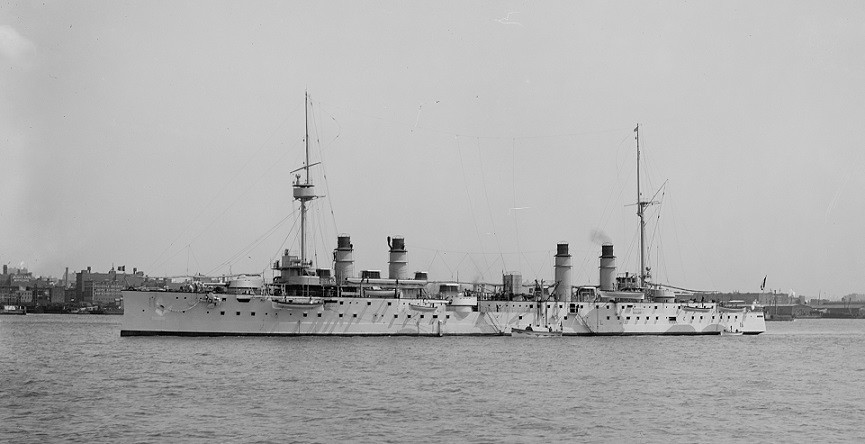
From the digital collections of the Library of Congress.
Healey
Posted 24 November 2018 - 07:56 AM
Second Battle of the Otranto Strait - July 25, 1917 (a second play)
We had another go at the hypothetical Otranto scenario, and the results could not have been more different. Whereas the first was one of two punch-drunk fighters unable to lay a glove on one another, this one saw a crushing defeat for the Austrians.
After two plays, it’s readily apparent that the scenario is quite unbalanced in favor of the French. Two Danton-class battleships are more than the equal of three Erzherzog Karl-class (born out by the VP assignments for each, 8 to 4). Not much in the second tier can stand up to a ten-gun 12-inch broadside, even when under local fire-control. Sure, the Austrian could complain of poor die-rolling, both in gunnery and in damage results (he suffered nine critical hits), but lady luck can only account for a sliver of his misery.
The French player, maintaining an unwavering ENE heading throughout, bored straight into the Austrians, who maneuvered into a favorable firing position early. Despite having crossed the French “T” (twice), the three Austrian BB’s failed to score salvo after salvo, the range closing to less than 3,000 yards briefly. The French 12-inch battery did not score often, but by the end, the equivalent hits were accumulating in grotesque fashion. Erzherzog Ferdinand Max was dispatched by a magazine hit roughly ninety minutes into the action, while Erzherzog Friedrich and Kaiser Karl VI were pounded to bits in the closing minutes (game was set for twenty turns, 120 minutes). The French lost a single destroyer, Protet, the victim once again.
We did remember this time to penalize the big guns when firing on the DD’s, allowing the small ships to close to extraordinarily close range (Bisson nearly collided with Erzherzog Karl at one point), but the greatly feared torpedo attack resulted in no hits. It was, however, successful (again) in distracting the Austrian BB’s, allowing Condorcet and Diderot to close to lethal range. Done…if this is ever played a third time we’ll just ignore the little buggers.
If only a bit of the early Austrian gunnery had found its mark, perhaps the outcome would have been less complete. However, it would seem that, if the result seen here is in any way indicative of the quality of their ships and combat skills, the Austrians did right keeping their fleet largely in port.
Posted 30 November 2018 - 05:14 PM
An unusual photo of coaling-at-sea operations, as developed by the Lidgerwood Manufacturing Company for the U. S. Navy:
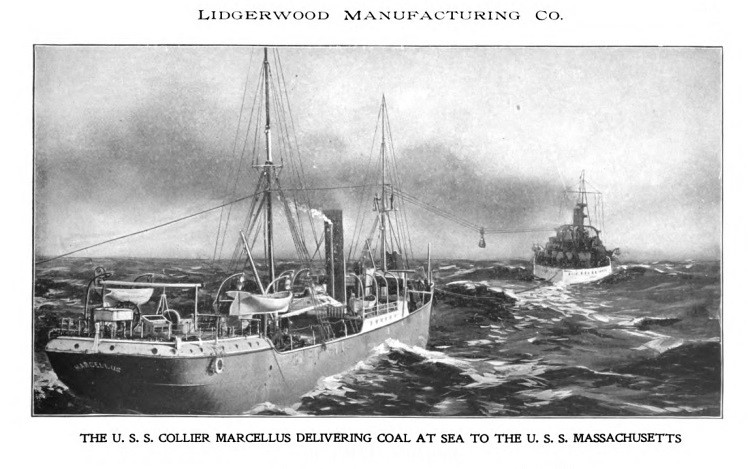
Lidgerwood manufactured the Lidgerwood Cableway, primarily for hoisting/conveying during excavation. The photo is from a 1900 sales booklet.
Posted 09 January 2019 - 10:39 AM
No action on the table for quite some time, but the workbench has been busy. Hoping to get some things going in the next few weeks.
Saw this photo while working on another project. Captioned simply as "U. S. S. Raleigh, the gun that fired the first shot at Manila":
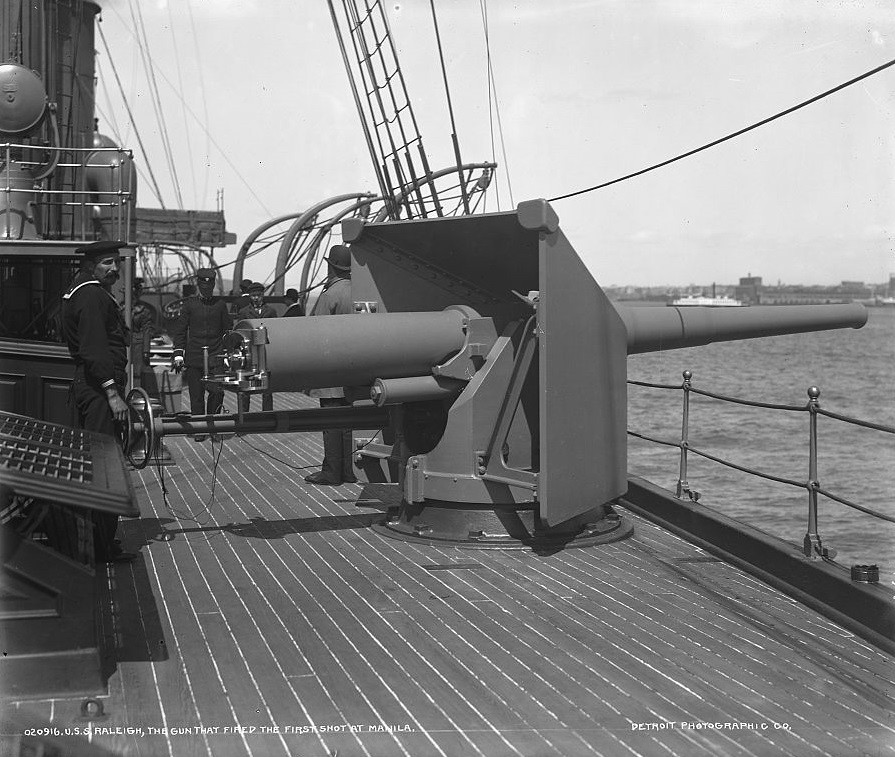
Photographed by Edward Hart of the Detroit Publishing Company, circa 1899-1901, from the Prints & Photographs Division of the Library of Congress.
Healey
Posted 21 February 2019 - 03:58 PM
Saving the Braunschweig (October 10, 1914)
With the outbreak of war, High Seas Fleet commander Vice Admiral Friedrich von Ingenohl had begun planning a series of probing sorties against the Channel and southeastern fleet defenses of Britain, intent on luring local forces, if not the Grand Fleet in aggregate, into a general or regional action. It was hoped that the HSF might wrest a temporary, if not permanent advantage over a degraded enemy, allowing further operations in the North Sea, or possibly interdiction of cross-Channel operations supporting the BEF. While not all resources were immediately available, Ingenohl deemed the fleet sufficient in strength to begin such operations (ultimately resulting in Hipper’s raid on Yarmouth in early November 1914 and the raid on Scarborough in mid-December, which Ingenohl would personally lead).
But this was early October, and he directed Vice Admiral Ehrhard Schmidt, commander of the IV Battle Squadron, to execute a raid on Calais, a French port actively utilized by the Allied armies in northeast France. IV Battle Squadron was a decidedly second-tier force, comprised of the five Braunschweig-class predreadnought battleships Braunschweig, Elsass, Hessen, Lothringen, and Preussen. Rebeur-Paschwitz’s IV Scouting Group would be dispatched as a covering force in support of Schmidt’s BBs.
IV Scouting Group departed Wilhelmshaven at 1930 October 9, 1914. IV Battle Squadron proceeded close behind, exiting the Jade at 2120. Schmidt’s intentions were to proceed southwest along the coast, with Rebeur-Paschwitz’s cruisers operating some twenty miles ahead and to his northwest. With Braunschweig as his flag, Schmidt proceeded at 12 knots, which would have him off Calais in the predawn hours of 11 October.
Scarcely an hour after exiting the Jade, Preussen reported engine problems limiting her top speed to less than 10 knots. Frustrated, but without hesitation, Schmidt ordered her back to port for repairs, continuing on with the remaining four BBs. Proceeding throughout the following day, IV Battle Squadron passed the darkened port town of Domburg at 0255 the morning of the 11th. The sea was calm, moonless, with thickening cloud-cover.
Lieutenant Commander Godfrey Herbert had been at sea for three days, having taken up patrol off the Belgian coast in submarine D5. Mid-patrol, he was scheduled to return to Harwich on 14 October. During the previous three days Herbert had observed nothing, and had moved his patrol area just southwest of Ostend. D5, a prewar sub launched in August 1911, was armed with two 18” bow torpedo tubes and one stern tube. The sub carried a single reload for each, six fish in total.

HMS D5.
Early on the morning of the 11th, while running on the surface within two miles of the Belgian coast, Herbert’s lookouts reported a column of ships approaching from nine or ten miles astern on a southwestward heading. At 0458 Herbert ordered D5 to submerge, slowly bringing her around for an approach. Having identified the oncoming ships as three-funneled German capitals, Herbert spent the next twenty minutes maneuvering D5 into a firing position. He had the coast at his back and the faint glow of the rising sun positioned behind the approaching enemy. At 0528 Herbert fired the first of his bow tubes at the lead ship, waited twenty seconds, then fired the second.
Vice Admiral Schmidt had just returned to Braunschweig’s bridge from a brief caucus in the chartroom when he felt the battleship shudder slightly, a geyser of water erupting from her port bow. Within minutes reports were received from below that a number of the forward compartments were rapidly flooding, and the ship had begun to settle slightly by the bow. In an effort to slow the inrush of water, the captain ordered her speed reduced to just five knots. Schmidt made the presumption that they’d wandered into an enemy minefield and ordered the remaining three BB’s to slow and turn northwest. Unbeknownst to Schmidt, D5’s second torpedo had slipped past, just a few yards astern of Braunschweig, well ahead of the following Elsass.
Unaware of whether he had hit anything, Herbert had his own problems. In an effort to bring D5 around for a stern shot, he had drifted a considerable distance and now found himself nearly running aground, bottoming in scarcely eight meters of water on an uncharted obstruction. Perhaps closer to shore than he’d originally realized, Herbert managed to pass over a shallow shelf without breaching D5 in plain view of the Germans, but by the time he’d gotten sufficient water underneath him, he was nearly three miles down range. Concerned about possible damage to the submarine’s pressure hull, Herbert made the decision to break off and proceed submerged to the southwest. At 0640, he brought D5 to the surface, radioing his current position and the approximate position of the enemy force he'd attacked nearly an hour before.
Schmidt remained convinced that Braunschweig had struck a mine and that others were likely about. Presuming his way blocked by an uncharted field, and with the sun slowly rising behind them, he ordered his three remaining BBs to reverse course and return to port. At 0750 he had himself and his flag taken off, transferred to Elsass. He then sent a signal to Rebeur-Paschwitz indicating his intentions, and requesting that a cruiser be sent back to assist Braunschweig in her effort to return to port. As Schmidt and Elsass moved off, he could see the wounded battleship slowly moving in a wide turn to the northeast, her forecastle nearly awash.
D5’s radio message to Admiralty did not go unnoticed. Within a couple of hours a scratch force was assembled from V Battle Squadron, already at sea in the eastern end of the Channel. Commanded by Rear Admiral Cecil Thursby, HMS Formidable, Irresistable, Implacable, and London were dispatched, along with a second scratch force comprised of a number of light cruisers and destroyers out of Harwich.
Fortunately for Braunschweig, the weather took a turn for the worse by mid-day. While the seas remained calm, a dense fog enveloped much of the Belgian coast and a light rain began to fall in the afternoon. Heroic efforts by the crew had staunched the flooding, and by 1400 Prinz Adalbert had arrived to take her in tow. With the cruiser’s assistance Braunschweig could make seven knots…she would need a lot of luck to get home.
With the weather miserable for the task at hand, Thursby took a chance, breaking up his column into a line-abreast formation, each ship separated by eight miles of open water. In this way he estimated he could gain roughly thirty miles of search frontage (although in the dense fog, it was deemed possible, but not likely, that an enemy could slip between the ships unnoticed). Using Herbert’s last reported contact position, Thursby would sweep the coast some 80 miles, roughly from Calais to the mouth of the Scheldt.
Captain Arthur Loxley stood on the bridge of Formidable, staring out into the damn muck ahead of them. Surging along at 12 knots, the visibility ahead and to either side of the old battleship couldn’t have been more than 800 yards. His terrier Bruce scurried around the deck at his feet, agitated, as was Loxley. Scarcely ninety minutes until dusk and nearly to the northwestern edge of Thursby's search area, they’d been at action stations for more than seven hours.
A shout went up from the forecastle, and then there, something, little more than a shadow, loomed from the mist in front of them. For just a moment the image of his wife and son, safe at home in the small bungalow in Portland, flashed through Loxley's mind, then disappeared. "Hard to starboard" he called to the helmsman, watching Bruce skitter across the linoleum as the ship began to lurch right. The shadow veered to his left, then disappeared into the soup.
"Bloody hell," he muttered to himself.
AAR to follow...
Posted 13 March 2019 - 11:46 AM
Posted 30 March 2019 - 09:51 AM
The umpire/referee submitted his scenario template this past week, including a number of minor rules "adaptations". For example, with regards to fog (7.17.2), the d6 roll for visibility is amended to allow up/down fluctuations in 1000-yard increments only. Turn 1 visibility will be 1000 yards...if the turn 2 d6 roll for visibility yields a “4” (implying 4000-yard visibility), visibility will instead only increase to 2000 yards, and so forth.
Another one-off relates to Braunschweig. She begins the game in tow at seven knots with two hull hits. She will maintain fire in her boilers, and if cast off she can proceed under her own power. However, if her speed exceeds seven knots, a d6 is rolled each turn she maintains that speed. On a roll “1” or “2”, her second hull hit reverts to a bulkhead hit and damage-control rolls are initiated. If successfully repaired, her speed maximums revert to those on her log. Any other simultaneous damage, should there be any, are followed as normal.
With regards to the possible entry of further ships, a list of ten candidates (including D5) has been compiled. A d20 will be used by the umpire to randomly indicate if/when they enter, a second chart developed to indicate their heading upon entry. Ships entering will be placed on the table at the edge of visibility from the nearest friendly or hostile ship as determined by the umpire. The owning player chooses entry speed. Only BB Formidable, cruising at 12 knots, begins on the table opposite the two Germans. No other ships enter on turns 1 through 3.
The action commences approximately eight miles off the coast. Should the combatants take an easterly, southeasterly or southern heading, approaching within three miles of the coast (as calculated by the umpire), a grounding table will be introduced. The Germans begin the game on a northeastern heading, running roughly parallel to the coast.
The game is limited to 20 turns (120 minutes), when it is presumed total darkness falls.
A few other minor tweaks, nothing significant. Players are back in town after this weekend, so first run-through should go off sometime in the next few weekends.
Fleet Action Imminent Forum →
Comments, Discussions & General Q&A →
Firing on small craft FAIStarted by Swagman1982 , 14 Feb 2019 |
|

|
||
Fleet Action Imminent Forum →
Comments, Discussions & General Q&A →
Swedish Navy WW1Started by Mel Spence , 23 Sep 2015 |
|
|
0 members, 1 guests, 0 anonymous users